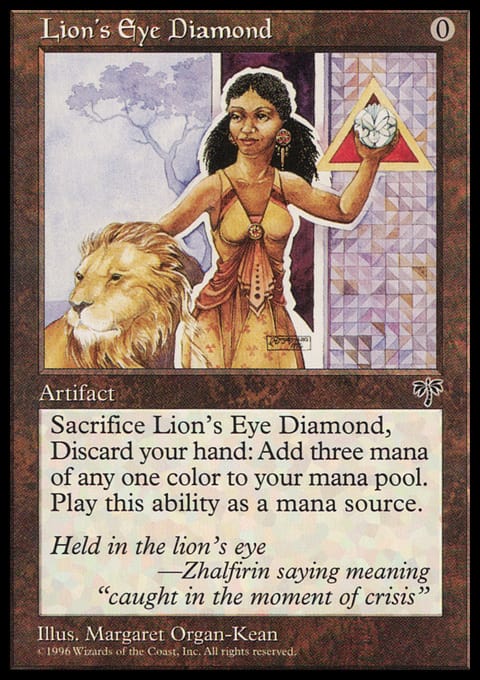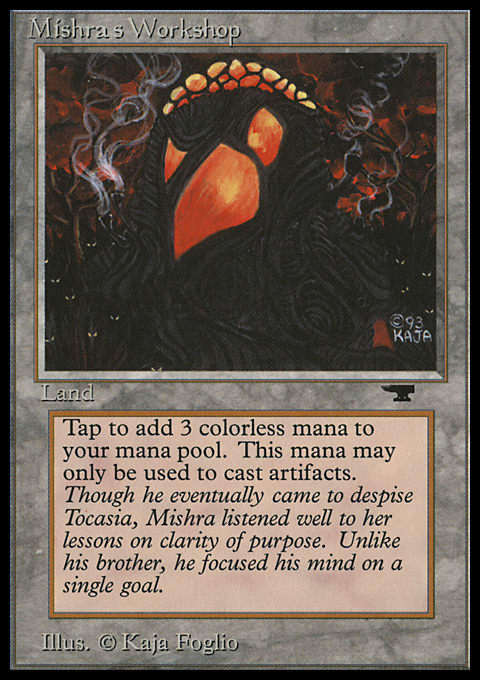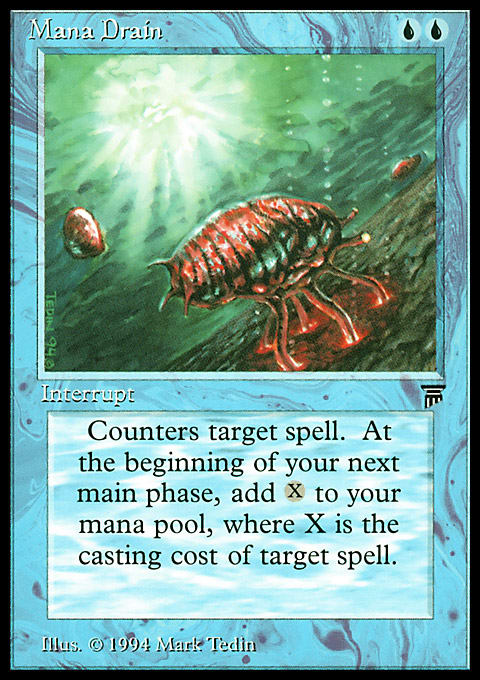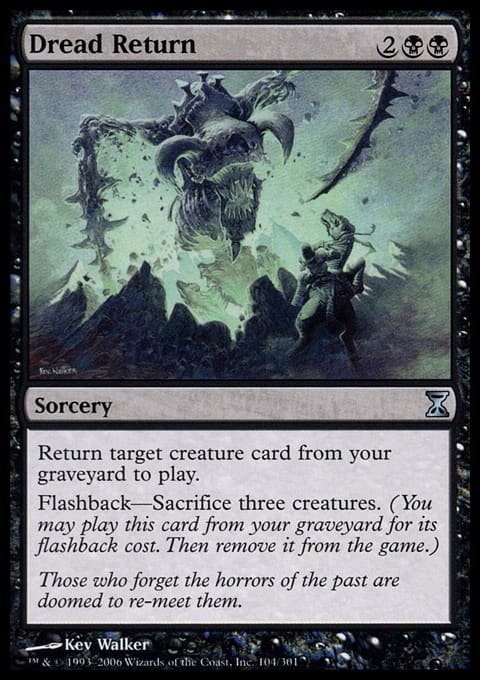Eternal Weekend is coming up at the end of the week, and this is the first year I will be able to attend the Vintage Championship since it moved from Gen Con in 2013. This is very exciting for me. I’ve been playing Magic: The Gathering since 1995, playing Vintage since 2005, and writing about it regularly for two years (formerly at LegitMTG), and even though I’ve played in Champs before, I finally acquired a complete set of Power that I’ll be able to use in full. This time, it’s official.
Why Play Vintage?
Encouraging Magic players to get into Vintage is a little like encouraging everyday drivers to take up Formula One racing. Feel the speed, the power, the danger, the thrilling near-misses! Yes, they may already have a car, whether it’s a beat-up hatchback or something a little faster and flashier, but they’re not going to compete with a something that generates 1,000 horsepower and goes 230 miles per hour—not even close. To participate at that level takes a certain mindset; for one: Not everyone would feel comfortable at that speed. Beyond that, though, it also takes a ton of money.
Likewise, everyone with a Magic deck can play Vintage. Standard decks are legal. Most Modern and Legacy decks would be legal, too, though some (with Lion's Eye Diamond, Lotus Petal, or Trinisphere and the like) would need to adjust for the restricted list. Decks like Affinity and Delver even have pretty close analogs in Vintage that experienced pilots would be able to leverage to earn some wins. But there’s still that power gap between Vintage and the rest of Magic that usually only money will close.
So, just as viewers can enjoy F1 racing at home on television, many players will be relegated to the sidelines to watch Vintage Champs coverage on stream, just as I had to the past couple of years. It’s a good opportunity to experience some of the tension and excitement vicariously, and seeing some of the nuances of Vintage play out should encourage people to try the format. Many new players and viewers acknowledge that the format is more balanced and interactive than they had previously assumed based on the powerful cards available. The interactions are fresh and different from those in other formats, and even though some of the cards might be older than their players, there’s always something new to see.
It may also surprise some readers to learn that Vintage is made more accessible by a network of tournaments in the U.S. and elsewhere that allow some number of proxies. In Ohio, where I play, most of our tournaments allow players to proxy any number of cards—an entire deck if necessary. The full seventy-five are rarely taken advantage of, even by complete neophytes, but the option also allows mad scientists to test new concepts without buying some of the weird, obscure things available in the format. Other events elsewhere allow ten or fifteen proxies (enough to cover the Power Nine plus a few others), and some have charged for additional proxies above a certain number.
The point is that, with a small collection of cards (many of which will be playable in Legacy, Modern, or Commander), Vintage really isn’t as out of reach as some detractors would have people believe. Rather, it’s a fun format with a great group of casual and competitive diehards that is always looking for new ways to get people playing.
I recommend it especially to train new Magic muscles. Instead of focusing on combat math and maximizing removal as in more creature-focused formats, you can learn to interact on the stack with intricate counter wars, aggressively draw and dig for threats and answers, and navigate a storm turn or Mishra's Workshop prison complex. It’s a different set of skills, but like those learned in Standard, Legacy, or whatever your format of choice, they still apply in Magic across the board in different forms.
A Vintage Overview
Many would-be Vintage players are introduced to the format with the idea of pillars: five cards and their resulting decks that form the basis for the metagame. These are Mana Drain, Mishra's Workshop, Dark Ritual, Bazaar of Baghdad, and Null Rod. It’s still how decks are grouped on The Mana Drain Vintage forums, and I’ve written about them in the past. There are some problems with this, though, beginning with the categories misleading, especially now. Workshop is still around, but Drain doesn’t really make the backbone of any current decks; neither does Dark Ritual or Null Rod. The Bazaar of Baghdad group used to be for things like Worldgorger Dragon Combo and Madness, but now it’s really just Dredge.
Plus, the pillars aren’t as flexible as they need to be. Can you imagine trying to do something similar with Legacy, trying to fit everything into boxes for the duration of a nonrotating format? Vintage changes with new printings (and restrictions and unrestrictions) just like other formats, so why not look at its decks with the same eye as other formats? Top down, what are the decks you’ll see at Vintage Champs, and how do they play?
Most decks in Vintage can still be categorized using the rock-paper-scissors analogue of aggro-combo-control, where aggro loses to combo, which loses to control, which loses to aggro, although of course it’s not that simple. These categories should be familiar to most players, but there are some differences in Vintage, too. In Vintage, there are two additional archetypes that don’t always appear elsewhere: tempo and prison. Tempo decks fall between control and aggro; rather than answering specific threats like control, they rely on early threats and some generic control and delaying tactics to win before the opponent’s game plan can be enacted. Prison decks try to prevent opponents from playing anything at all using a strict regimen of mana denial and cost increasers.
Also in Vintage, most decks will transition between different strategies quickly. My favorite example of this is Bomberman. Bomberman at heart is a strong control deck using Mana Drain, other counters, and a Trinket Mage toolbox for cards like Engineered Explosives, Nihil Spellbomb, and Pithing Needle to answer individual threats. However, Trinket Mage also fuels Auriok Salvagers combo by finding Black Lotus to make limitless mana and win with Tasigur, the Golden Fang or just a handful of counters. And there are other games in which a couple of early Trinket Mages or other creatures can win in the red zone against an opponent unprepared for an aggro rush. So, one deck, depending on the situation and the opponent, could take any of three different stances and will change between them even during a single game.
Right now, there are four top decks in Vintage: Forgemaster Shops (sometimes called Martello Shops), Monastery Mentor Control, B/U/G Griselbrand Oath, and Dredge. The Forgemaster and Mentor decks are both using the most powerful cards available, and Oath and Dredge both exist as reactions to those. The lists presented here are just examples of what to look for.
Forgemaster Shops — Prison, Aggro, Combo
Forgemaster Shops ? Vintage | Montolio
- Creatures (18)
- 1 Phyrexian Metamorph
- 1 Steel Hellkite
- 1 Sundering Titan
- 1 Triskelion
- 2 Hangarback Walker
- 4 Kuldotha Forgemaster
- 4 Lodestone Golem
- 4 Phyrexian Revoker
- Spells (24)
- 1 Black Lotus
- 1 Mana Crypt
- 1 Mox Emerald
- 1 Mox Jet
- 1 Mox Pearl
- 1 Mox Ruby
- 1 Mox Sapphire
- 1 Sol Ring
- 1 Staff of Nin
- 1 Trinisphere
- 2 Sphere of Resistance
- 4 Chalice of the Void
- 4 Tangle Wire
- 4 Thorn of Amethyst
- Lands (18)
- 1 Strip Mine
- 4 Ancient Tomb
- 4 Mishra's Factory
- 4 Mishra's Workshop
- 4 Wasteland
- 1 Tolarian Academy
- Sideboard (15)
- 1 Batterskull
- 3 Crucible of Worlds
- 1 Ghost Quarter
- 4 Grafdigger's Cage
- 3 Metalworker
- 2 Precursor Golem
- 1 Wurmcoil Engine
Currently, this is the top deck in the format, evidenced by Brian Demars and Paul Mastriano winning Champs byes at Gen Con. As with most Mishra's Workshop–based decks, the primary plan is prison, preventing the opponent from playing spells with Sphere of Resistance, Thorn of Amethyst, and Chalice of the Void. From there, the deck can win using either beatdown with Lodestone Golem (using Tangle Wire to hold the opponent’s head under) or switch to combo mode with an active Kuldotha Forgemaster. It’s a brutal attack, and the transition from prison to a creature-based endgame is facilitated by the deck’s superior mana, which helps it play around its own lock pieces.
However, the Workshop archetype is linear and has very few ways to draw cards, fix its hand, or find answers in a hurry without Kuldotha Forgemaster. This means that, in many cases, if the opponent can pull ahead with creatures, mana, or a bomb like Tinker or Oath of Druids, it’s possible to stay ahead and win the game. Massive amounts of cheap (because of the Spheres), creature-based (because of Thorn), and broadly costed (because of Chalice) artifact removal is the answer. Ingot Chewer and Hurkyl's Recall are the current best places to start, but there are plenty of cards that say, “Destroy target artifact.”
Monastery Mentor — Control, Combo, Tempo
Monastery-mora ? Vintage | Kevin Cron
- Creatures (5)
- 1 Snapcaster Mage
- 4 Monastery Mentor
- Planeswalkers (2)
- 2 Dack Fayden
- Spells (37)
- 1 Ancestral Recall
- 1 Brainstorm
- 1 Hurkyl's Recall
- 1 Mindbreak Trap
- 1 Misdirection
- 2 Swords to Plowshares
- 3 Dig Through Time
- 3 Gush
- 4 Flusterstorm
- 4 Force of Will
- 4 Mental Misstep
- 1 Ponder
- 1 Time Walk
- 1 Treasure Cruise
- 3 Mystic Remora
- 1 Black Lotus
- 1 Mox Pearl
- 1 Mox Ruby
- 1 Mox Sapphire
- 1 Sensei's Divining Top
- 1 Sol Ring
- Lands (16)
- 2 Island
- 2 Cavern of Souls
- 2 Flooded Strand
- 3 Tundra
- 3 Volcanic Island
- 4 Scalding Tarn
- Sideboard (15)
- 4 Ingot Chewer
- 4 Containment Priest
- 1 Hurkyl's Recall
- 3 Engineered Explosives
- 1 Path to Exile
- 1 Mountain
- 1 Plains
Monastery Mentor decks, and closely related Young Pyromancer Delver decks, use the Best Draw Engine in Vintage (Preordain into Gush into Dig Through Time) to control the game and then combo with their namesake creature. There’s also potential to land Mentor, Pryomancer, or Delver of Secrets early and win just by playing a few key counter and draw spells in a tempo role. As they’re built now, Mentor decks are usually going to be control–combo, using fewer creatures and holding the game until Mentor resolves and then using it like a white Tendrils of Agony to win next turn. Delver decks with Pyromancer are usually tempo-oriented, with more creatures that come down earlier and win before the opponent can establish.
Because these decks are meant to run lean, on light mana bases supported by an extensive and powerful draw engine, one of the best ways opponents can beat them is with a Mishra's Workshop–based prison strategy. Dropping an early threat—especially like Oath of Druids, which takes advantage of the creatures Mentor and Delver decks play—can also be an effective counter strategy, setting up a combo before the draw engine comes online. In either case, it’s really the draw engine that needs to be stopped. Once multiple Gushes or Digs resolve, the game can get out of hand for Mentor’s opponents quickly.
Oath of Druids — Control, Combo
B/U/G Oath ? Vintage | Rich Shay
- Creatures (3)
- 3 Griselbrand
- Spells (42)
- 1 Ancestral Recall
- 1 Brainstorm
- 1 Dig Through Time
- 1 Memory's Journey
- 1 Vampiric Tutor
- 2 Flusterstorm
- 2 Misdirection
- 4 Force of Will
- 4 Mental Misstep
- 1 Demonic Tutor
- 1 Time Walk
- 1 Yawgmoth's Will
- 2 Thoughtseize
- 3 Show and Tell
- 4 Preordain
- 4 Oath of Druids
- 1 Black Lotus
- 1 Mana Crypt
- 1 Mox Emerald
- 1 Mox Jet
- 1 Mox Pearl
- 1 Mox Ruby
- 1 Mox Sapphire
- 1 Time Vault
- 1 Voltaic Key
- Lands (15)
- 2 Island
- 1 Polluted Delta
- 2 Tropical Island
- 2 Underground Sea
- 4 Forbidden Orchard
- 4 Misty Rainforest
- Sideboard (15)
- 2 Pithing Needle
- 4 Abrupt Decay
- 4 Nature's Claim
- 1 Forest
- 2 Nihil Spellbomb
- 1 Hurkyl's Recall
- 1 Strip Mine
Oath of Druids is a regular part of the Vintage metagame as the most efficient way to bring the format’s best creatures into play; currently, that creature is Griselbrand. Most of the time, the deck combines Oath with Forbidden Orchard to trigger it, but that’s less important now that the format’s two best decks are playing and winning with multiple creatures. The game plan is often to control the game with counters and removal until Oath resolves. Then, with Griselbrand drawing cards, the deck either switches immediately to a fast combo win with Time Vault and Voltaic Key (or even, like, Time Walk) or it continues controlling the game with a 7/7 flying, lifelinking, draw engine.
As a deck, Oath works because its primary game plan is so simple: All you have to do is resolve a 2-drop enchantment and have it survive a turn until its trigger can resolve, too. That’s relatively easy against Workshop prison and against Mentor or Delver decks before their draw engines come online. Post-’board, Oath meets its biggest challenge when answers like Grafdigger's Cage and Containment Priest come in. Usually, these games push Oath into an even stronger control game, where Abrupt Decay is the critical answer.
Dredge — Combo, Aggro
Dredge ? Vintage | Travis Compton
- Creatures (27)
- 1 Fatestitcher
- 1 Flame-Kin Zealot
- 2 Ingot Chewer
- 3 Golgari Thug
- 3 Ichorid
- 4 Bloodghast
- 4 Golgari Grave-Troll
- 4 Narcomoeba
- 4 Stinkweed Imp
- 1 Elesh Norn, Grand Cenobite
- Spells (17)
- 1 Nature's Claim
- 2 Dread Return
- 2 Unmask
- 4 Cabal Therapy
- 4 Bridge from Below
- 4 Serum Powder
- Lands (16)
- 1 Dakmor Salvage
- 3 Petrified Field
- 4 Bazaar of Baghdad
- 4 Mana Confluence
- 4 Undiscovered Paradise
- Sideboard (15)
- 2 Ingot Chewer
- 3 Wispmare
- 3 Rending Volley
- 2 Contagion
- 1 Chain of Vapor
- 2 Nature's Claim
- 2 Unmask
Befitting a deck filled with Zombies and Horrors, Dredge is the terror of the Vintage format. Main deck, it’s a powerful, graveyard-based strategy that wins quickly and doesn’t need to play a regular game of Magic, in the sense of “needing mana” or “casting cards from hand.” Dredge can be difficult to react to in Game 1 since, even if the dredging-into-Dread Return combo is stopped, there will still be a horde of Zombies and self-reanimating creatures to contend with. Aside from fast combo or some otherwise amazing or terrible luck on one side or the other, Dredge will almost certainly win Game 1.
Post-’board, Dredge has several options, mostly based on the assumption that the opponent will bring in swaths of graveyard-hate cards: again Grafdigger's Cage and Containment Priest, but also things like Ravenous Trap, Tormod's Crypt, and Yixlid Jailer. Usually, Dredge would try to overwhelm its opponent’s hate with anti-hate—things like bounce and artifact or creature removal. Dredge may also go around by simply hard-casting its creatures and attacking; Narcomoeba and Bloodghast can go a long way. Other sideboard plans might turn Dredge into a non-graveyard combo (Divining Witch and Laboratory Maniac; Vampire Hexmage and Dark Depths) or into a bigger aggro deck (Dragonlord Dromoka and more mana, no kidding).
Beyond these four, there are many other decks that will do well at Vintage Champs, but they won’t be as commonly played. Merfolk (tempo, aggro) won in 2013, played by Joel Lim, and is still a threat with counters, landwalk, and a solid mana base. Landstill (based around Standstill and Mishra's Factory, usually in blue with white, red, or both) and The Answer (U/R based around Magus of the Moon and Chalice of the Void) are both strong control decks with prison plans that have been good against both Dig Through Time and Forgemasters.
There are other decks playing Workshops as well. Espresso Stax is more dedicated to the prison plan and will try to win games via concession to being locked out by Smokestack and Crucible of Worlds, with wins coming from Mishra's Factory, Mutavault, and artifact creatures. It has a strong game against most blue decks but can be weak against other ’Shops, where its mana denial and prison plan are less effective. Frobots, named after Eric Froelich, who popularized the deck, starts with the prison plan but pushes the aggro aspect by adding Arcbound Ravager, which is also helpful against Dack Fayden and spot removal like Ingot Chewer. It can further extend its reach by comboing Ravager with Triskelion.
Pure combo—which in Vintage is usually represented by Tendrils of Agony storm decks, but has also included those that aggressively play for Time Vault and Voltaic Key (Steel City Vault variants) and things like Goblin Charbelcher—hasn’t been a major presence recently, but it always has a chance to win just because its cards are so objectively powerful. Usually, these decks will have a few counterspells for control, and they may be able to hold the fort a few turns, but the main idea in Game 1 is going to be combo, winning in one big turn.
You probably notice that all of the decks have a combo element. This is part the nature of Vintage: Games can end quickly when one player or the other is out of answers. I should add that it’s rare for this to occur early (that is, on turn one) without a decent punch and counterpunch from both sides.
You may also notice that there really aren’t many straight aggro decks. It may be a backup plan for some decks if, instead of finding their game winning combo pieces, they just find more random dudes, but there’s not a Zoo-type deck in Vintage and hasn’t been for several years. Some of the more regular attempts at aggro are made by decks like Affinity, Goblins, and Infect, all of which (of course) have combo elements as well.
So that’s the quick guide to Vintage for anyone watching this year’s Eternal Weekend coverage. Of course, if you can actually be on site to play and watch some games and hang out, that’s even better, but I guarantee no shortage of great cards, crazy plays, and discussion the following Monday. I’ll be back with a follow-up report then as well, looking at where Vintage is going in the last third of 2015.
Thanks for reading! I’m looking forward to hosting lots more Vintage content here. Feel free to contact me here or on Twitter with any questions or comments.
Nat Moes





























